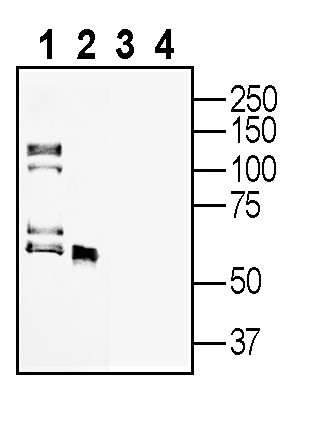Overview
- Peptide CDLIQSK(S)LSKNYTTD, corresponding to amino acid residues 252 - 267 of mouse GRN (Accession P28798). Secreted.
Progranulin Blocking Peptide (BLP-NR178)
 Western blot analysis of rat brain lysates (lanes 1 and 3) and rat spleen membranes (lanes 2 and 4):1-2. Anti-Progranulin Antibody (#ANR-178), (1:400).
Western blot analysis of rat brain lysates (lanes 1 and 3) and rat spleen membranes (lanes 2 and 4):1-2. Anti-Progranulin Antibody (#ANR-178), (1:400).
3-4. Anti-Progranulin Antibody, preincubated with Progranulin Blocking Peptide (BLP-NR178). Western blot analysis of human U-87 MG glioblastoma cell line lysate (lanes 1 and 5), human K562 myelogenous leukemia cell line lysate (lanes 2 and 6), human MCF-7 breast adenocarcinoma cell line lysate (lanes 3 and 7) and mouse BV-2 microglia cell line lysate (lanes 4 and 8):1-4. Anti-Progranulin Antibody (#ANR-178), (1:400).
Western blot analysis of human U-87 MG glioblastoma cell line lysate (lanes 1 and 5), human K562 myelogenous leukemia cell line lysate (lanes 2 and 6), human MCF-7 breast adenocarcinoma cell line lysate (lanes 3 and 7) and mouse BV-2 microglia cell line lysate (lanes 4 and 8):1-4. Anti-Progranulin Antibody (#ANR-178), (1:400).
5-8. Anti-Progranulin Antibody, preincubated with Progranulin Blocking Peptide (BLP-NR178).
The Progranulin (PGRN) protein is encoded by the GRN gene composed of 13 exons, although exon 1 is non-coding. PGRN is a secreted glycoprotein with growth factor like properties, consisting in 7.5 tandem repeats of a 12-cysteine module called granulin or epithelin domain separated by linker regions. The 12-cysteine motif forms six disulfide bridges with the peptide backbone adopting a unique three-dimensional structure of a parallel stack of beta hairpin1,2.
PGRN is synthesized as a 68.5 kDa protein that is N-glycosylated to become a mature secreted 88 kDa protein3. Secreted PGRN is cleaved into 6 kDa granulin peptides, each composed of cysteine repeat motifs. Cleavage of PGRN occurs at the intra-linker spacer regions by several proteases including elastase4, proteinase5, matrix metalloproteinase-146 and ADAM metallopeptidase with thrombospondin type 1 motif7. PGRN cleavage is inhibited by secretory leukocyte protease inhibitor (SLPI)4 and high-density lipoprotein (HDL)/Apolipoprotein A-I complex8.
PGRN is expressed in several tissues showing a prominent expression in epithelial, immune and, neuronal cells9. In particular, a strong expression of PGRN mRNA was found in highly proliferative epithelia including those of the intestinal crypt, skin, and reproductive tracts9. In contrast, PGRN shows low expression in less proliferative and highly differentiated cells such as those of alveolar lung and renal tube epithelia9.
PGRN shows high expression in peripheral immune system tissues such as spleen and lymph nodes9 and is also highly expressed in the central nervous system (CNS) with expression in both neurons and neuroinflammatory cells. PGRN has been detected in neurons of the neocortex, hippocampus, arcuate nucleus and ventromedial hypothalamus, Purkinje cells of the cerebellum and in motor neurons9. In the CNS, PGRN can function as neurotrophic growth factor increasing cell viability10 and neurite outgrowth [11]. PGRN knockdown in rat hippocampal neurons results in decreased neuronal arborization and length and synaptic densities12 showing its role in neuronal morphology and establishing interneuron connections.
Several proteins have been identified as receptors for GPRN, including Sortilin, which is considered the major regulator of GPRN in the brain, as well as, EphA2, LRP1, Notch and more13.
Loss of function mutations in the GRN gene, cause a range of neurodegenerative disorders including frontotemporal dementia (FTD), amyotrophic lateral sclerosis (ALS), Alzheimer's and Parkinson's disease 13.
